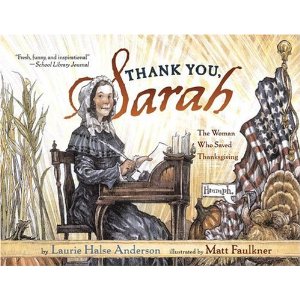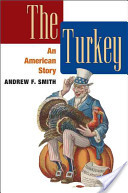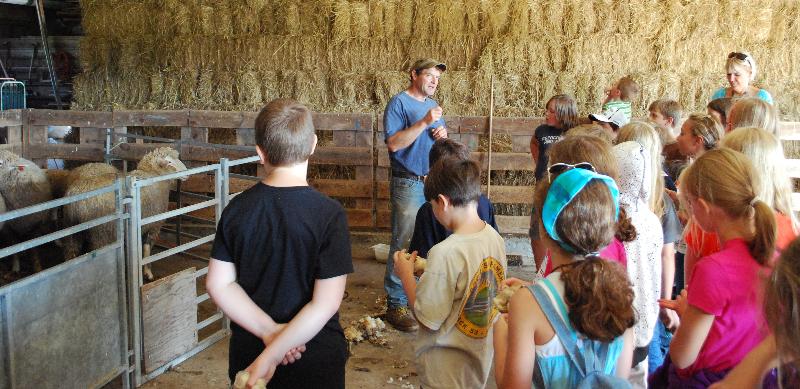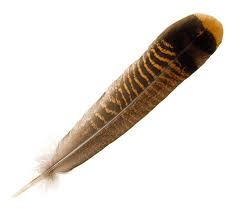|
Turkey Books
There are plenty of entertaining children's books about turkeys but not many that look at the facts. Most end with the turkey being spared from being being served as the Thanksgiving meal. Though this may be fun for children it is not necessarily the message we want to be teaching if we are attempting to convey the facts about our food. Use this as an opportunity to teach children about making informed decisions.
Duck for Turkey Day by Jacqueline Jules | |
This is more of a story about how different food traditions develop rather than about turkeys, but is a good book for grades 1-3 to look at multiculturalism.
Thank You Sarah by Laurie Halse Anderson shares the tale of how Sarah Hale advocated for a national Thanks-giving holiday. It's a nice historical story which illustrates the role that individuals can play in bringing about change. Good for grades 1-4.

The Turkey: An American Story by Andrew F. Smith is more of a reference book than a story. It provides a historical review of the bird and its influence on human history. Recipes from the 16th-19th centuries are included.

|
|
Calendar
10/2-8: National 4-H Week
10/7: NEA-NH Fall Conference
10/8-10: Sandwich Fair
10/15-16: Goffstown Giant Pumpkin Weigh-Off
& Regatta
10/22: Keene Pumpkin Festival
10/22: Master Gardener & Natural Resource Stewards Conference (open to all)
10/23-24: NH Science Teachers Fall Conference
10/26: National Pumpkin Day
11/5: Raising Turkeys in Your Backyard
11/19: Upper Valley Farm to School Conference
Do you know of an ag. related event that we should list in our calendar? Let us know: nhaitc@nhfarmbureau.org
| |
|
|
Greetings,
Fall in New Hampshire is a time of beauty and bounty. Local farms are harvesting produce and preparing for the upcoming holiday season. What better time to think about where our food comes from?
Recently 270 Lakes Region fourth graders did just that at the Second Annual Belknap County School to Farm Day. Ramblin' Vewe Farm in Gilford hosted the day and a dozen other farmers or agriculturally related organizations set up stations to help the children learn how farmers provide us with food, fiber and fuel. The students had the opportunity to meet a dairy farmer, drive a team of oxen, taste maple syrup and honey, learn about hydroponic farming, enjoy apples, pet chicks, dig into soil, explore vegetable and tree growth, and feel fresh wool and woolen products. After a day with farmers I asked them, "Are farmers important to us?" They enthusiastically replied, "YES!" We talked about ways that farmers help us and how we can help farmers. The students expressed the importance of buying food from farmers, visiting farms and maybe even becoming a farmer someday. At least one of the schools that participated in this event is purchasing local meat from a farm in Loudon for their lunch program. That's a great way to make the connection between learning and doing. To find out more about getting local food into cafeterias, contact the NH Farm to School program at 862-2542 or www.nhfarmtoschool.org. See the calendar listing for the upcoming Upper Valley Farm to School conference.

In this issue you'll find information and resources about a truly American food - the turkey. This iconic bird has come to symbolize cultural history, abundant feasts, family traditions, and much more. Check out the turkey trivia and resources that can help you integrate some turkey talk into your curriculum.
Best wishes,
Ruth
Ruth Smith, Statewide Coordinator |
|
Turkey Trivia and Resources
- Adult male turkeys are called "toms" and make a "gobble, gobble" sound which can be heard up to a mile away. Females are called "hens" and make a wide variety of clucking sounds.
- Tom turkeys strut, puff out their breast, and spread their tail feathers to impress females. Many of the photographs and graphics that depict turkeys show this posture, though it is not the usual stance of the bird.
- The incubation period for a turkey egg is 28 days at which point the baby or poult emerges. As they get older the juvenile birds are called jakes (male) and jennies (female).
- Wild turkeys are native to North America and were commonly hunted by Native Americans long before Europeans set foot here.
- In the 1500's Spanish explorers brought turkeys from Mexico to Spain and they became established as an important meat bird in Europe. They were so well liked that some claim the Pilgrims brought turkeys to America on the Mayflower!
- Wild turkey populations declined with European colonization and subsequent settlement due to hunting and habitat loss. They are a species of the woodland and were not adapted to the conversion of forests to pasture and crop land. All wild turkeys were gone from much of their original range by the mid 1800's.
- New Hampshire's wild turkey population was also extirpated (eliminated) 150 years ago, but reintroductions in 1975 have led to a healthy rebounding of the population. There are now an estimated 25,000 wild turkeys spread throughout the state and it is legal to hunt them within specific dates in the spring and fall. For more information about wild turkeys in NH visit the NH Fish & Game website: http://www.wildlife.state.nh.us/Wildlife/Wildlife_profiles/profile_wild_turkey.htm
- There is no proof that turkey was actually eaten at the infamous meal shared by the Pilgrims and the Wampanoag in 1621. It is believed that turkeys did not become a traditional part of a Thanksgiving meal until 1800. Thanksgiving itself was not an official holiday until October 3, 1863 when President Abraham Lincoln declared the Thanksgiving Day proclamation.
- Learn more about the history of wild turkey in North America at http://www.nwtf.org/conservation/bulletins/bulletin_14.pdf
- To learn more about the biology and life history of wild turkeys visit: http://www.allaboutbirds.org/guide/Wild_Turkey/lifehistory
- Americans consumed only 1.7 pounds of turkey per person in 1935. In 2010 they consumed 16.4 pounds per person. Much of that was in the form of deli meat.
 - Turkey farmers in the U.S. raised 244 million turkeys in 2010. Most of those came from Minnesota, North Carolina and Arkansas.
- Learn more about commercial turkey farming at the National Turkey Federation website: www.eatturkey.com
- To learn about a few turkey farmers in NH see this article at: www.home.comcast.net/~seacoastnewengland/turkeyfarms.html
|
|
Turkey Activities
Here are some fun ways to integrate turkey studies into your curriculum.
- Turkeys have 5-6000 feathers on their bodies. Examine feathers as a way to learn about birds and the unique qualities of feathers. It is illegal to possess feathers of song birds but because turkeys are game birds, it is fine to use them. You might find some in the woods, ask a hunter or turkey farmer or even purchase them at a craft store. Their size makes them easy to handle and work with.

Use turkeys as a way to teach about life cycles. Turkey poults are precocial meaning they are active shortly after hatching and ready to leave the nest within 12-24 hours. Compare that to most song birds which are altricial and need much more time to develop into self sufficient young.
- Study the history of Benjamin Franklin's interest in turkeys. Various sources state that Franklin wanted the turkey for our national symbol instead of the bald eagle. However, there are other resources that say that is a myth. Help students learn to dig deeper, use multiple sources and develop investigative skills that can help them be good researchers.
Learn turkey anatomical terminology to practice vocabulary. For example: dewlap= fleshy growth under the chin; caruncles=growth on the side and front of the neck; snood=fleshy protrusion above the bill; spur=boney spike on legs; beard=bristles that hang from chest.
- Listen to the sounds that turkeys make and practice distiguishing between them. To listen to turkey sounds visit: www.nwtf.org.
The population of wild turkeys in NH has fluctuated greatly through the centuries from common to nearly extinct to common again. Have your students research that change and create a population chart. Discuss the causes of decline and repopulation as a way to study human impact on wildlife. View agricultural statistics on the populations of domestic turkeys for comparison. |
|
|